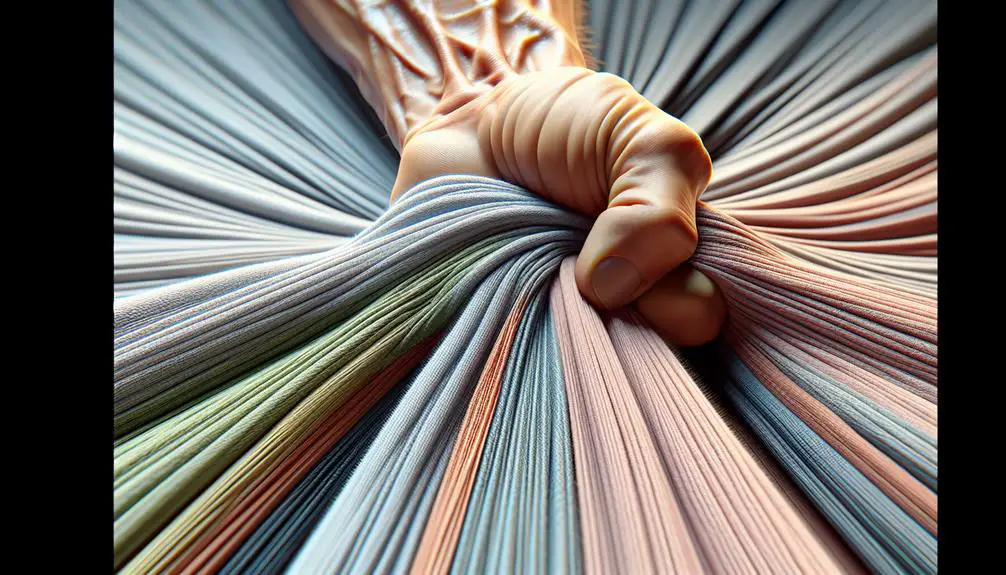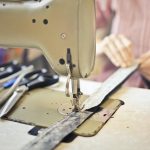It's no coincidence that you've stumbled upon this topic while looking to understand why some fabrics last longer than others. Tensile strength and fabric durability aren't just technical jargon; they're essential in choosing the right material for any application, whether it's industrial use or sportswear. Have you ever wondered what makes one fabric tear easily while another seems nearly indestructible? By grasping the concept of tensile strength and the factors that affect it, you'll gain valuable insight into making informed decisions about fabric selection. Curious to know how these elements impact fabric performance?
Table of Contents
Key Takeaways
- Tightly woven fabrics exhibit higher tensile strength and durability.
- Fiber type and weave pattern significantly impact fabric tensile strength.
- High tensile strength fabrics resist tearing and stretching.
- Moisture-wicking and antimicrobial properties enhance fabric durability.
- Testing methods like the grab test determine fabric tensile strength.
Understanding Tensile Strength
Tensile strength measures how much force a fabric can withstand when it's pulled apart before breaking. When you explore the tensile properties of fabrics, you're essentially understanding their capacity to endure stress without succumbing to damage. This knowledge is vital for anyone looking to master fabric strength and durability.
Fabric construction plays a pivotal role in determining tensile strength. The way fibers are woven or knitted together can greatly influence a fabric's stress resistance. For example, tightly woven fabrics generally exhibit higher tensile strength compared to loosely woven ones. The interplay between the yarn's density and the weave pattern creates a strong structure that can better withstand pulling forces.
Understanding tensile properties isn't just about the fabric's immediate ability to resist breaking; it's also about anticipating how it performs under various conditions. High tensile strength fabrics are crucial for applications demanding durability, such as in industrial materials, sportswear, and outdoor gear.
Grasping the intricate details of fabric strength empowers you to make informed decisions when selecting materials for specific uses, ensuring longevity and reliability. By mastering these concepts, you elevate your expertise in fabric durability to a professional level.
Factors Affecting Tensile Strength
You're about to learn how material composition and weave patterns greatly impact tensile strength. Different fibers and their blends affect how much stress the fabric can endure.
Additionally, the way fibers are interlaced in the weave pattern plays an essential role in determining the fabric's overall strength.
Material Composition Impact
The strength of a fabric largely depends on the materials it's made from and their inherent properties. To master the material impact on tensile strength, you need to focus on the composition influence.
Different fibers, whether natural like cotton or synthetic like polyester, contribute uniquely to the overall strength and durability of the fabric. For instance, cotton offers comfort but may lack the tensile strength that polyester provides. On the other hand, nylon's elasticity can greatly enhance durability.
When conducting a strength analysis, consider the molecular structure of the fibers. Natural fibers typically have less uniformity, which can lead to varying strengths within the same fabric type. Synthetic fibers are engineered for consistency, often resulting in superior tensile strength and durability.
Your durability assessment should also account for how these materials react under stress, including resistance to tearing and stretching.
Understanding these factors equips you to make informed choices about fabric selection for specific applications. Whether you're designing outdoor gear that requires high durability or everyday wear that balances comfort and strength, knowing the material composition impact is essential.
Mastery in this area ensures that you select fabrics that perform optimally for their intended use.
Weave Pattern Significance
When evaluating fabric strength, consider how various weave patterns impact tensile properties. The weave pattern's significance can't be overstated as it directly influences fabric performance. For example, plain weaves, characterized by a simple over-under pattern, offer balanced strength and durability but may not provide the flexibility some applications require.
Conversely, twill weaves, with their diagonal rib pattern, enhance fabric strength and resistance to tearing, making them suitable for heavy-duty uses. Understanding weave structure is essential. A tighter weave typically results in higher fabric strength, as the threads are closely packed, distributing stress more evenly. However, a looser weave might offer greater breathability and flexibility, which could be more suitable for certain garments or applications.
The relationship between weave structure and fabric strength is a fundamental aspect of textile engineering. To master fabric performance, you must analyze how each weave pattern aligns with your specific needs. Whether you're designing robust workwear or elegant evening attire, choosing the right weave pattern will guarantee the fabric meets your tensile strength requirements.
Testing Tensile Strength
By measuring how much force a fabric sample can withstand before breaking, you can effectively determine its tensile strength. Mastering tensile testing techniques is crucial to this process.
You'll typically use a tensile testing machine, which gradually applies force to the fabric until it breaks. As the force increases, you'll generate stress-strain curves, which graphically represent the fabric's response to stress and provide essential insights into its performance capabilities.
To enhance your understanding, focus on fabric tear resistance and elongation properties. Tear resistance measures how well a fabric withstands tearing, an essential factor for durability.
During testing, you'll observe how the fabric stretches and at what point it starts to tear. Elongation properties, on the other hand, indicate how much a fabric can stretch before it breaks. High elongation means the fabric can endure more stretching, which often translates to greater durability.
Understanding Fabric Durability
Ever wondered what makes some fabrics last longer than others? The key lies in understanding fabric durability and how it relates to fabric construction and tensile strength.
When you aim for mastery in selecting or working with fabrics, recognizing these elements is essential.
Fabric construction plays a pivotal role in durability. The way fibers are woven or knitted together affects how well a fabric can withstand wear and tear. A tightly woven fabric typically offers greater durability because the dense structure resists abrasion and stress better. Conversely, loosely woven fabrics might feel softer but are generally less resistant.
Tensile strength, the measure of how much stress a fabric can endure before breaking, directly impacts its longevity. Fabrics with high tensile strength resist tearing and stretching, maintaining their form and function over time.
For example, materials like nylon and polyester are known for their exceptional tensile strength, contributing to their extensive use in high-performance and long-lasting products.
Factors Influencing Durability
When considering fabric durability, you should focus on three main factors:
- Material composition
- Weave pattern
- Environmental exposure
Each of these elements can greatly impact how long your fabric lasts.
Material Composition Impact
The durability of a fabric largely depends on its material composition and the inherent properties of those materials. When you choose a fabric, understanding the material composition is essential because it directly affects tensile strength and overall fabric durability.
Natural fibers like cotton and wool offer breathability and comfort but may lack the tensile strength of synthetic fibers such as nylon and polyester. These synthetic materials often boast higher tensile strength, making them more resistant to wear and tear.
For example, if you're looking for a fabric that withstands heavy use, opting for a material with a balanced blend of natural and synthetic fibers can offer the best of both worlds—comfort and durability. The tensile strength impact of a fabric can be measured through standardized tests, which quantify how much force the fabric can withstand before breaking.
Materials with high tensile strength generally translate into longer-lasting fabrics, ideal for applications requiring robust performance. Knowing the properties of different materials helps you select fabrics that meet your specific needs, ensuring longevity and performance.
Weave Pattern Importance
Understanding how weave patterns influence fabric durability can greatly impact your choices for different applications. When you select a fabric, you're not just looking at color or texture; the weave pattern plays a pivotal role in its longevity and performance. Different weave patterns can either enhance or diminish a fabric's durability, making your weave pattern selection vital.
Consider the following factors when evaluating weave patterns:
- Strength: Tight weaves, like plain or twill, offer greater tensile strength, making them ideal for heavy-duty applications.
- Fabric Aesthetics: Complex weaves, such as satin or jacquard, enhance visual appeal but may sacrifice some durability.
- Textile Innovation: Cutting-edge weaves incorporate new materials and techniques, pushing the boundaries of traditional fabric performance.
- Abrasion Resistance: Patterns like ripstop are designed to prevent tearing, extending the fabric's lifespan significantly.
- Flexibility: Some weaves provide greater stretch and flexibility, which can be critical for specific uses, such as activewear.
Your understanding of weave pattern impact on durability will empower you to make better-informed decisions, whether you're selecting materials for upholstery, apparel, or industrial uses. Mastery in weave pattern selection not only boosts fabric aesthetics but also ensures you're leveraging the latest in textile innovation for best performance.
Environmental Exposure Effects
Exposure to environmental elements like sunlight, moisture, and pollutants can greatly influence a fabric's durability. UV exposure effects are particularly detrimental; prolonged sunlight can weaken fibers, causing them to become brittle and eventually break. To counteract this, fabrics designed for outdoor use often incorporate UV-resistant treatments.
Moisture resistance is another critical factor. When fabrics are exposed to water or humidity, they can lose strength, especially if they're made from natural fibers like cotton. Mold and mildew may also develop, further degrading the material. Opt for moisture-resistant finishes to extend the lifespan of such fabrics.
Heat resistance is equally important. High temperatures can cause fibers to melt or deform, compromising the fabric's structural integrity. Fabrics intended for high-heat environments should be crafted from heat-resistant materials like aramid fibers.
Chemical reactions can also degrade fabric. Pollutants and chemicals in the air or water can cause discoloration, weakening, and even dissolution of fibers. Fabrics exposed to harsh chemicals should undergo specific treatments to enhance their chemical resistance.
Testing Fabric Durability
To test fabric durability, you need to evaluate how well the material withstands various stressors like abrasion, tension, and repeated use. Start by conducting a thorough fabric quality assessment to see if it meets established durability standards. This process guarantees the material's longevity and helps identify any weaknesses that could lead to premature wear and tear.
You'll want to perform a wear and tear analysis, which involves simulating real-world conditions to observe how the fabric holds up over time. This is essential for predicting fabric longevity and guaranteeing it can endure daily challenges.
Here are five necessary tests you should consider for a detailed evaluation:
- Abrasion Resistance Test: Measures how well the fabric resists surface wear from rubbing.
- Tensile Strength Test: Assesses the fabric's capacity to withstand tension without breaking.
- Pilling Resistance Test: Checks for the formation of small fiber balls on the surface.
- Seam Strength Test: Evaluates the strength of seams under stress to guarantee they don't tear easily.
- Flexing Endurance Test: Determines how the fabric performs under repeated folding and bending.
Comparing Fabric Types
When comparing fabric types, you'll notice that each material offers unique strengths and weaknesses that suit different applications. Cotton, for instance, is prized for its comfort and breathability but lacks the tensile strength found in synthetic fibers like nylon or polyester.
In contrast, nylon boasts excellent tensile strength and fabric longevity, making it ideal for high-stress situations like outdoor gear and athletic wear.
A key aspect of fabric comparison involves looking at durability factors. Natural fibers such as wool and silk offer luxurious textures but can wear out more quickly compared to synthetic counterparts. Wool's tensile strength is moderate, suitable for garments and interiors, but less so for heavy-duty use. Polyester, on the other hand, combines high tensile strength with significant resistance to abrasion and stretching, making it a versatile choice for a wide range of applications.
Understanding these durability factors will help you make informed decisions. For instance, if you need fabric longevity, opt for synthetics like Kevlar or Spectra, which are engineered to withstand extreme conditions.
Applications of High-Tensile Fabrics
High-tensile fabrics find extensive use in industries ranging from aerospace to sportswear, thanks to their exceptional strength and durability. You'll see these fabrics in a variety of applications where reliability and performance are non-negotiable. Understanding these uses can help you appreciate why high-tensile materials are so highly valued.
In the world of extreme sports, high-tensile fabrics are indispensable. They provide the necessary resistance against tears and abrasions, ensuring your gear stands up to the harshest conditions. From rock climbing harnesses to paragliding wings, durability is key.
Military gear benefits greatly from high-tensile fabrics. Soldiers rely on materials that can withstand challenging environments. These fabrics are used in everything from ballistic vests to rugged uniforms, providing essential protection and longevity.
Here are other significant applications of high-tensile fabrics:
- Aerospace: Used in constructing lightweight yet strong aircraft components.
- Automotive: Essential for robust seat belts and airbags.
- Outdoor gear: Guarantees tents, backpacks, and jackets can endure extreme conditions.
- Medical textiles: Create durable and sterile surgical gowns and bandages.
- Marine applications: Ideal for sails and ropes that resist saltwater corrosion.
Tips for Selecting Durable Fabrics
Choosing durable fabrics involves considering key factors like material composition, weave type, and intended use. Start with the fabric selection by prioritizing high-quality materials such as natural fibers like cotton and wool, or synthetic options like nylon and polyester. These materials often boast superior tensile strength and resistance to wear and tear.
Next, examine the weave type. Tighter weaves generally offer better durability. For instance, twill and satin weaves are more robust than plain weaves, providing extra resilience for frequently used items. Don't overlook the importance of thread count; higher counts usually indicate stronger, more lasting fabric.
Intended use is another essential longevity factor. For outdoor applications, fabrics that are UV-resistant and water-repellent, like solution-dyed acrylics, will endure harsh conditions. For upholstery, look for fabrics with high rub counts to withstand continuous friction.
Don't forget to check for finishes and treatments, such as stain resistance or antibacterial properties, which can enhance fabric longevity.
Frequently Asked Questions
How Can Tensile Strength Be Improved in Fabric Manufacturing?
To enhance tensile strength, concentrate on fabric weaving techniques and apply chemical treatments. Meticulously manage materials, ensuring each thread's tension is tight. By doing so, you'll strengthen the fabric, ensuring durability and superior performance.
What Are Common Misconceptions About Fabric Durability?
You might think fabric construction guarantees wear resistance, but it's a misconception. Washing techniques and fiber strength play pivotal roles. Over-washing can weaken fibers, reducing durability, so mastering proper care is essential for long-lasting fabrics.
How Does Weather Exposure Affect Tensile Strength?
Weather exposure greatly impacts fabric strength. UV damage weakens fibers, leading to reduced tensile strength. Moisture compromises fabric integrity, causing mold and mildew. By understanding these effects, you'll better preserve and maintain your fabric's durability.
Are There Eco-Friendly Fabrics With High Tensile Strength?
When it comes to eco-friendly options that don't compromise on strength, you can rest assured. Sustainable materials like hemp and bamboo are tough as nails, providing high tensile strength while keeping the environment in mind.
What Role Does Fabric Maintenance Play in Durability?
Proper cleaning methods and fabric storage greatly impact the longevity of your fabrics. By preventing wear and tear, you'll guarantee your materials last longer, maintain their strength, and continue looking their best over time.
- Tetron Fabric for Marine Applications: Durability and Use Cases - June 18, 2025
- Tetron Fabric for Outdoor Furniture: Weather Resistance and Care - June 18, 2025
- Tetron Fabric for Wall Coverings: Style and Application Tips - June 18, 2025





